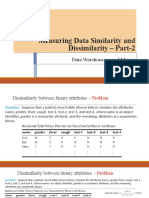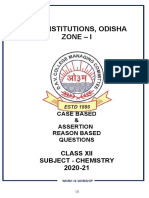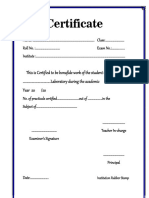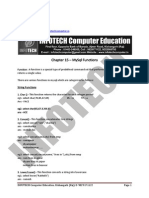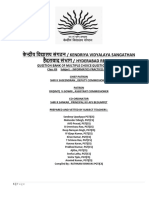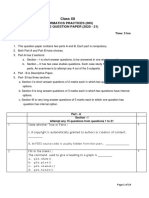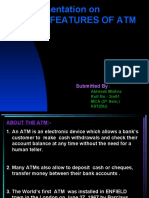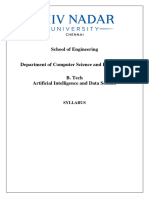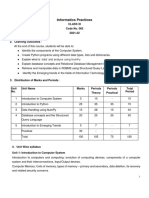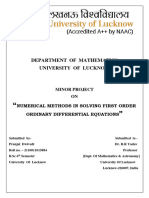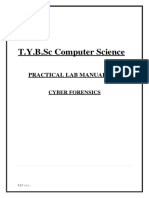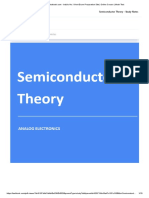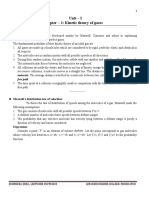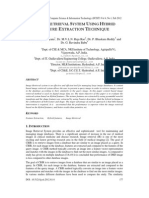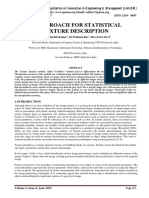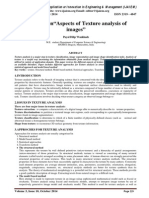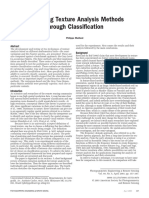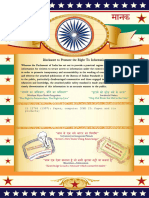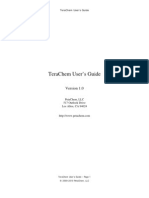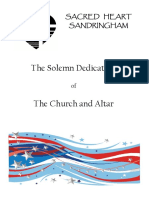ISSN XXXX XXXX © 2017 IJESC
Research Article Volume 7 Issue No.4
Survey on Texture Feature Extraction Methods
Renu Bala
Research Scholar
Abstract:
Feature Extract ion is a method of capturing visual content of images for indexing & retrieval. Primitive or low level image
features can be either general features, such as extraction of colo r, texture and shape or domain specific features. and also plays an
important role in feature extract ion process. Features are two types gernal features and domain specific features. Gernal (visual)
features like co lor, texture, and shape features. The proposed work describes the concept of various texture feature extraction
methods such as structural based, statistical based, model based and transform based methods.
Keywords: GLCM, LBP, statistical methods, second order statistics.
1. INTRODUCTION edges fro m the image appropriately. Sobel operator is based
Image processing is a method to convert an image into on edge detection. Dig ital image processing is very vast in
digital form and perform some operations on it, in order to get different areas and different applications and also establish
an enhanced image or to extract some useful information fro m reliable and validate results. [8]. Retrieval is fetching valuable
it. It is a type of signal dispensation in which input is image, informat ion that related with representation, storage and
like video frame or photograph and output may be image or accessing. Content based image retrieval is the technique that
characteristics associated with that image. It is a process for extract or retrieve features on the behalf of low level features
extracting relevant information fro m an image. After detecting such as color, texture and shape. Color informat ion retrieved
an input, some valuable informat ion extracted fro m the image using color spaces like HSV, RGB etc. and various methods of
which are used in next step for identify ing the image. Feature representation color histograms, color mo ments, color
extraction starts from an in itial set of measured data and builds coreelogram, co lor coherence are applied for the purpose of
derived values (features) intended to be informat ive and non - color feature extraction. Texture represented low level patterns
redundant, facilitating the subsequent learning and and also texture classified as statistical methods, structural
generalization steps, and in some cases leading to better methods and spectral methods [6]. Texture analysis is one of
human interpretations. the most important techniques which characterize tissue to
Texture is a repeated pattern of information or define changes in functional characteristics of organs in the
arrangement of the structure with regular intervals. In a disease. Proposed work explained the concept of texture
general sense, texture refers to surface characteristics and analysis for detection of abnormalities in CT images that are
appearance of an object given by the size, shape, density, above human. There is four sgldm features ext racted energy,
arrangement, proportion of its elementary parts. Texture entropy, local homogeneity, inertia based on gldm. Sg ld m,
feature extracted using several methods. Such as structural glrlm all are helpfu l to find texture differences between
based method, statistical based methods, model based normal liver and abnormal liver and extract diagnostic
methods, transform based methods. informat ion [3]. Descriptor based signature is to decompose
the color image into three monochromatic images. Then key
2. LITERATURE S URVEY point detection is performed on each color channel. A key
point detector that produces an output of low count is
CBIR is the process of retrieving images fro m the fundamental to any matching technique that relies on image
database and extract features on the basis of shape, texture, descriptors. A low count of key points allows the solution to
and color. Haar wavelet method used to retrieve content based compare only significant points, speeding up the process and
images, vector is used to calculated Haar Wavelet features. yielding a more robust and discriminative set of features. A
Features of image are extracted and analyzed. Co lor, texture, mu ltitude of different key point detectors have been proposed
shape features described by using Gabor filter, Canny edge in co mputer vision while it is common for feature descriptors
detection, color histograms [2]. The Searching of local to propose their own key point detectors [14].
histogram Euclid ian distance has been used for feature
extraction. Features of image calcu lated by comparing 3. Texture Feature Extracti on Methods .
histograms. Proposed work considered feature extraction
techniques and methods. RGB, HSV, edge detector descriptors Textu re feature ext racted using several methods. Such as
explained for retrieval process and gradient operator fetch the structural based method, statistical based methods, model
based methods, transform based methods.
International Journal of Engineering Science and Computing, April 2017 10375 http://ijesc.org/
� Fig: 1. Texture extraction methods .
Structural texture analysis techniques describe a texture as the its neighborhood. The estimated parameters of the image
composition of well-defined texture elements such as regularly models are used as textural feature descriptors. Model based
spaced parallel lines. Structural methods define structural methods are fractal and stochastic models. AR model,
features of object or image. Structural feature based on Gaussian-Markov, RMF model, Gibbs RMF. The
topological and geometric properties. Structural features are as autoregressive (AR) model assumes a local interaction
Horizontal lines, Vertical lines, No. of end points, No. of cross between image pixels in that pixel intensity is a weighted sum
points, Horizontal curves at top or bottom, no. of straight of neighboring pixel intensities. A Markov rand om field
lines, circles, intersections etc. This type of knowledge known (MRF) is a probabilistic process in which all interactions are
as structure of object. Statistical features identify from local the probability that a cell is in a given state is entirely
statistical distributions of pixels. These features can be easily determined by probabilit ies for states of neighboring cells.
detected as compared to structural features. Such as number of Fractal models describe objects that have high degree of
zones(points). For e.g. Character A has three zones. Statistical irregularity. Statistical model for fractals is fractional
methods are as zoning, projection histograms, crossing and Bro wnian motion. Transform based texture analysis
distances, n-tuples. Statistical features are first order statistics techniques convert the image into a new form using the spatial
(one pixel), second order statistics (two pixel), higher order frequency properties of the pixel intensity variations. such as
statistics (one or more pixels). Statistical texture analysis Fourier, Gabor, and wavelet t ransforms.
techniques describe texture of regions in an image through
higher-order mo ments of their grayscale histograms. The most 3.1 Second order statistics
commonly used method for texture analysis is based on
extracting various textural features fro m a gray level co - Second order statistics estimate properties of two or
occurrence matrix (GLCM). Model based texture analysis more p ixel values occurring at specific locations relative to
techniques describe an empirical model of each pixel in the each other. These are following types.
image based on a weighted average of the pixel intensities in
Fig : 2. Second order statistics
International Journal of Engineering Science and Computing, April 2017 10376 http://ijesc.org/
� Proposed work some probabilities of low level descriptors techniques BTC”, international journal of co mputer
on combination of texture, color, shape using gray scale application, vol.-6 no.-8, September 2010.
images. GF and GLCM exp lored texture and RGB define nine
color combinations for feature extraction and frequency layout [11] Gaurav Ku mar “A detailed review of feature extraction in
of the accuracy is shown using Gabor filter [12]. Features are image processing system”, fourth international conference on
extracted, classified, and selected in proposed work. process of advance computing and communicat ion technologies 2014
classification extracted those images which are not selected. [12] M iroslave BENCO. “Novel method for texture feature
Normalizat ion is used to remove the size in the image and extraction based on GLCM”. Rad io engineering, vo l-16, no.-4,
histogram processing and normalizat ion of pixels is used for December.
color processing. Statistical and structural method used for
texture features and co-occurrence matrix define entropy, [13] Igor Barros Barbosa1, Ali E. Abdallah, “On the us e of
energy, correlation and difference, shape features extracted fingernail images as transient biometric identifiers (Bio met ric
based on contours and regions of images [15]. recognition using fingernail images)” Springer-Verlag Berlin
Heidelberg 2015
4. Conclusions
[14] Leutenegger,“binary robust invariant scalable keypoints”.
Dig ital image processing includes three types of visual Co mput.Vis. IEEE Int. Conf.0,2548– 2555 ,2011
features like colo r, shape, texture. These are known as low
level features and based on high level features. Texture is a [15] Ryszard S. Choras,“Image feature extraction techniques
visual and repeated patterns has properties as coarseness, fine, and their applications of CBIR and BIO metrics system”,
regularity, contrast, entropy energy etc. lbp, glcm sgld m and international journal of biology and biomedical engineering,
glrlm are the methods used for texture information extraction. vol-1, 2007.
All are second order statistics.
5. References
[1] Aihua Zheng, “Structure Based Feature Extraction in
Basketball Zone-Defense Strategies “International Journal of
Co mputer Science and Applications 2010
[2] Arun Verma, “Content based image retrieval using color,
texture and shape feature”, International Journal of Co mputer
Science and Software Engineering. Vo l. 4, May 2014.Print
[3] A.H. Mir, “Texture analysis of CT images”, IEEE
Engineering in Medicine and Biology November-December
1995. Print
[4] Abdul Kadir, “Leaf classification using color, texture, and
shape features”,
International Journal of Computer Trends and technology.
July to august 2011.
[5] Andrzej Materka and Michal Strzelecki, “Texture Analysis
Methods – A Review” 1998
[6] A mandeep Khokher, Rajneesh Talwar, “Content Based
Image Retrieval: Feature Extract ion Techniques and
Applications”, International Journal of Computer Application
2012
[7] John R.Smith, Sh ih Fu Chang, “Tools and Techniques for
Color Image Retrieval”, 1995
[8] Chesti Altaf, “color histogram based image retrieval”,
international journal of advance engineering technology.
[9] C. Rathgeb, “A survey on biometric cryptosystems and
cancelable biomet rics’. EURASIP Journal on Informat ion
Security, 2011(1):3, 2011
[10] Dr. H.B. Kekre, “image retrieval with shape feature
extracted using gradient operator and slope magnitude
International Journal of Engineering Science and Computing, April 2017 10377 http://ijesc.org/


